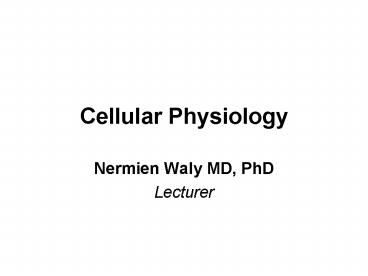Cellular Physiology - PowerPoint PPT Presentation
1 / 24
Title: Cellular Physiology
1
Cellular Physiology
- Nermien Waly MD, PhD
- Lecturer
2
House-keeping rules
- Attendance.
- Cell phones off, please.
- Breaks and food.
- Loos!
- Questions welcomed
- any time.
- Exams and evals.
3
Course objectives
- To define the word physiology (
- To be able to identify the system your drug is
dealing with - To be able to understand the mechanism by which
this system is working with. - To be aware of the possible interactions between
different systems
4
Overview
- What is physiology
- The human body (functional point of view)
- Body fluid (water)
- The cell (living units of the body)
- Control systems
5
Physiology
- It is the science of explaining the physical and
chemical factors that are responsible for the
origin, development, and progression of life. - Physiology can be divided into viral, bacterial,
plant physiology and many more divisions. - In human physiology we attempt to explain the
specific characteristics and mechanisms of the
human body that make it a living being.
6
The human body
Leonardo Davinci vitruvian man
7
Body systems
- Nervous system
- Endocrine system
- Myoskeletal system
- Cardiovascular system (CVS)
- Lymphatic system
- Respiratory system
- Digestive system
- Urinary system
- Reproductive system
- Hematopoietic system (blood)
- Immune system (RES)
- Special senses (vision hearing)
8
Body water
- 60 of body weight is water
- 40 of body weight is ICF (intracellular)
- 20 of body weight is ECF (extracellular)
9
ICF ECF
- Intracellular
-
- 2/3rd of body water
- K, Mg, protein
- pH acidic
- Osmolarity 290
- Plasma, interstitial fluid
- 1/3rd of body water
- Na,Cl-, HCO3-
- pH alkaline
- Osmolarity 290
- Osmolarity is concentration of particles in
solution expressed as osmole per liter - pH is the logarithmic expression of hydrogen ion
concentration
10
The cell
- Standard cell (merely hypothetical!)
- Specialized cell neurons, muscle cells, red
blood cells, hair cells and many others. - Any cell is comprised mainly of cell membrane and
intracellular organelles
11
The cell membrane
- Structure lipid bilayer (phospholipids),
protein, cell connections e.g. gap junctions. - Functions protection, support, transport,
cell-body and cell-cell interaction. - Cell characteristics life, division,
nourishment, etc..
12
Cell organelles
- Nucleus
- Mitochondria
- SER and RER
- Golgi apparatus
- Ribosomes
- lysosomes
13
Transport across cell membrane
- Diffusion simple or facilitated .
- Active transport primary or secondary.
Co-transport or counter-transport. Na-K ATPase
pump as an example of primary active transport. - Osmosis its a water thing (
14
Break (
15
Simple and Facilitated diffusion
16
Na-K ATPase pump
- Significance Drugs acting on this mechanism e.g.
cardiac glycosides - Other pumps Ca pump, H,K pump.
17
Secondary active transport
- Co-transport and counter-transport.
- Significance!
18
Osmosis
19
Neurons as an example of specialized excitable
cells
20
Membrane characteristics of excitable cells
- Excitable cells are capable of spontaneously
firing electrical impulses e.g. nerve cells and
cardiac myocytes - Membrane potentials resting (RMP) and action
potential. - Depolarization and repolariztion
21
Resting Membrane Potential
- -70 mV .
- Depolarization
- Repolarization.
22
Action potential
23
Cell-cell interaction/communication
- Anatomical e.g. gap and tight junctions
- Electrical nerve signals- action potentials
- Chemical neurotransmitters, hormones. The role
of receptors.
24
Control systems
- Nervous system (nerve signals/action potentials)
- Endocrine system (hormones)
- Feed back mechanism as a characterstic of control
system.
25
Thank you































